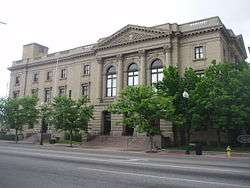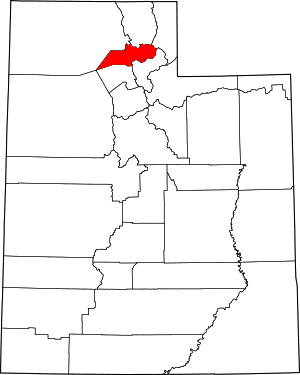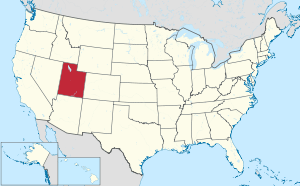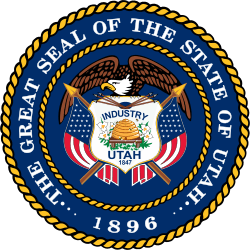Weber County, Utah
Weber County (/ˈwiːbər/ WEE-bər) is a county in the U.S. state of Utah. As of the 2010 census, the population was 231,236,[1] making it Utah's fourth-most populous county. Its county seat and largest city is Ogden,[2] the home of Weber State University. The county was named for the Weber River.
Weber County | |
|---|---|
 | |
 Location within the U.S. state of Utah | |
 Utah's location within the U.S. | |
| Coordinates: 41°18′N 111°55′W | |
| Country | |
| State | |
| Founded | January 31, 1850 (created) March 3, 1852 (organized) |
| Named for | Weber River |
| Seat | Ogden |
| Largest city | Ogden |
| Area | |
| • Total | 659 sq mi (1,710 km2) |
| • Land | 576 sq mi (1,490 km2) |
| • Water | 83 sq mi (210 km2) 13% |
| Population (2010) | |
| • Total | 231,236 |
| • Estimate (2019) | 260,213 |
| • Density | 350/sq mi (140/km2) |
| Time zone | UTC−7 (Mountain) |
| • Summer (DST) | UTC−6 (MDT) |
| Congressional district | 1st |
| Website | www |
Weber County is part of the Ogden-Clearfield, UT Metropolitan Statistical Area as well as the Salt Lake City-Provo-Orem, UT Combined Statistical Area.
History
The Weber Valley was visited by many trappers seeking beavers and muskrats along its streams. One of the first on record reached the area in 1824, traveling from Fort Bridger. He reported that the Bear River flowed into a salt bay. Peter Skene Ogden passed through in 1826, representing the Hudson's Bay Company. He traded in this area for several years, near present-day North Ogden. John C. Frémont explored the Weber Valley in 1843, and made maps of the area. The Fremont reports encouraged readers to seek their fortunes in the western frontier. Miles Goodyear was a fur trapper who constructed a way station on the Weber River in 1845. In 1847 he sold it to incoming Mormon pioneers. James Brown made the purchase, and changed the name of the site to Brownsville (it was later changed to Ogden).[3]
After the Mormon pioneers began filling out into the future state of Utah, the fledgling government (as of 1849 known as State of Deseret) began a system of government. On January 31, 1850 the legislature provided for the creation of six counties to generally cover the area, named in this order:
- Weber (with Ogden as county seat)
- Great Salt Lake
- Utah
- San Pete
- Tuilla
- Little Salt Lake[4]
The county boundaries were better-defined by the 1852 Utah Territory legislature. The borders were adjusted by subsequents acts in 1855, in 1856, and in 1862. The creation of Nevada Territory in 1862 also administratively reduced the county's territory by a significant degree, since its 1852 description had it running to the Sierra Nevada mountains in central California. A final adjustment in 1880 concerning the various lands in the Great Salt Lake area brought the county's borders to their present configuration.[5]
As of the 1852 description, the original Weber County stretched from California in the west, to the Oregon boundary on the north, to a point in middle Davis County in the south.[6] As Nevada and the State of Utah evolved, Weber County was trimmed so that it now occupies a stretch of the Wasatch Front, part of the eastern shores of Great Salt Lake, and much of the rugged Wasatch Mountains.
Geography
The county extends from high in the Wasatch Range in the east into a portion of the Great Salt Lake to the west. The Weber and Ogden rivers and their tributaries run through its valleys.[7] The Weber County Surveyor's office divides the county into two regions, the "Lower Valley" and the "Upper Valley", divided by the ridge of the Wasatch front range south through the county. Lower Valley, adjacent to the Lake, is the county's more populous part. The Upper Valley consists mostly of the Ogden Valley, the watershed of the Ogden River. The county's highest elevation is Willard Peak in the Wasatch Mountains, at 9,763' (2976m) ASL.[8] The county has an area of 659 square miles (1,710 km2), of which 576 square miles (1,490 km2) is land and 83 square miles (210 km2) (13%) is water.[9] It is the second-smallest county in Utah by land area and third-smallest by total area.
Major highways
- United States Interstate I-15
- United States Interstate I-84
- United States Highway US-89
- Utah State Highway UT-37
- Utah State Highway UT-39
- Utah State Highway UT-79
- Utah State Highway UT-97
- Utah State Highway UT-108
- Utah State Highway UT-126
- Utah State Highway UT-134
- Utah State Highway UT-162
- Utah State Highway UT-158
- Utah State Highway UT-167
- Utah State Highway UT-203
- Utah State Highway UT-204[7]
Adjacent counties
- Box Elder County - northwest
- Cache County - north
- Rich County - northeast
- Morgan County - southeast
- Davis County - south
- Tooele County - southwest
Protected areas
- Cache National Forest (part)
- Ogden Bay Waterfowl Management Area
- Weber Memorial Park
- Willard Bay Upland Game Management Area (part)[7]
Lakes
- Causey Reservoir
- Pineview Reservoir
Demographics
| Historical population | |||
|---|---|---|---|
| Census | Pop. | %± | |
| 1850 | 1,186 | — | |
| 1860 | 8,675 | 631.5% | |
| 1870 | 7,858 | −9.4% | |
| 1880 | 12,344 | 57.1% | |
| 1890 | 22,723 | 84.1% | |
| 1900 | 25,239 | 11.1% | |
| 1910 | 35,179 | 39.4% | |
| 1920 | 43,663 | 24.1% | |
| 1930 | 52,172 | 19.5% | |
| 1940 | 56,714 | 8.7% | |
| 1950 | 83,319 | 46.9% | |
| 1960 | 110,744 | 32.9% | |
| 1970 | 126,278 | 14.0% | |
| 1980 | 144,616 | 14.5% | |
| 1990 | 158,330 | 9.5% | |
| 2000 | 196,533 | 24.1% | |
| 2010 | 231,236 | 17.7% | |
| Est. 2019 | 260,213 | [10] | 12.5% |
| US Decennial Census[11] 1790–1960[12] 1900–1990[13] 1990–2000[14] 2010–2019[1] | |||
2010 census
As of the 2010 United States Census, there were 231,236 people in the county, organized into 78,784 households and 57,867 families.[15] The population density was 351/sqmi (135/km²). There were 86,187 housing units at an average density of 131 per square mile (50/km²).[15] The racial makeup of the county was 85.2% White, 1.4% Black or African American, 1.3% Asian, 0.8% Native American, 0.3% Pacific Islander, 6.59% from other races, and 3.0% from two or more races. 16.7% of the population were Hispanic or Latino of any race.[15]
In the 2000 United States Census, there were 196,533 people in the county, organized into 65,698 households and 49,536 families. The population density was 341/sqmi (132/km²). There were 70,454 housing units at an average density of 122 per square mile (47/km²). The racial makeup of the county was 87.69% White, 1.40% Black or African American, 1.28% Asian, 0.77% Native American, 0.16% Pacific Islander, 6.59% from other races, and 2.12% from two or more races. 12.65% of the population were Hispanic or Latino of any race.
By 2005 80.4% of the population was non-Hispanic whites. 1.5% was African-Americans while 0.9% was Native American. Asians were 1.4% of the population. Latinos were 15.2% of the county population.
There were 78,748 households out of which 36.8% had children under the age of 18 living with them, 56.7% were married couples living together, 11.5% had a female householder with no husband present, and 26.5% were non-families. 21.1% of all households had an individual who was 65 years of age or older and 7.3% had someone living alone who was 65 years of age or older. The average household size was 2.90 and the average family size was 3.40.[15]
Ages
| Age Range | Number | Percent |
|---|---|---|
| Under 5 years | 20,837 | 9.0 |
| 5 to 9 years | 19,667 | 8.5 |
| 10 to 14 years | 18,375 | 7.9 |
| 15 to 19 years | 17,261 | 7.5 |
| 20 to 24 years | 17,636 | 7.6 |
| 25 to 29 years | 19,131 | 8.3 |
| 30 to 34 years | 17,469 | 7.6 |
| 35 to 39 years | 14, 559 | 6.3 |
| 40 to 44 years | 12,899 | 5.6 |
| 45 to 49 years | 14,160 | 6.1 |
| 50 to 54 years | 14,123 | 6.1 |
| 55 to 59 years | 11,904 | 5.1 |
| 60 to 64 years | 9,824 | 4.2 |
| 65 years and over | 23,388 | 10.1 |
The median age was 30.7 years. For every 100 females, there were 100.7 males. For every 100 females age 18 and over, there were 99.0 males.[15]
Income and employment
As of the 2010 census, the median income for a household in the county was $62,036, and the median income for a family was $71,359. Males had a median income of $49,081 versus $34,954 for females. The per capita income for the county was $25,275. 12.1% of the population and 8.7% of families were below the poverty line. Out of the total population, 15.4% of those under the age of 18 and 8.5% of those 65 and older were living below the poverty line.[15]
The 2000 census found, the median income for a household in the county was $44,014, and the median income for a family was $49,724. Males had a median income of $36,239 versus $24,719 for females. The per capita income for the county was $18,246. 9.30% of the population and 6.90% of families were below the poverty line. Out of the total population, 11.10% of those under the age of 18 and 5.50% of those 65 and older were living below the poverty line.
In the 2010 census, 67.0% of people over 16 were in labor and 33.0% were not in labor. The unemployment rate was 3.2%.[15]
Ancestry
As of 2017, the largest self-identified ancestry groups in Weber County, Utah were:[16]
- English (21.6%)
- German (10.5%)
- "American" (7.5%)
- Irish (6.1%)
- Scottish (4.1%)
- Danish (3.9%)
- Italian (3.6%)
- Dutch (3.1%)
- Swedish (3.0%)
- Welsh (1.9%)
- Norwegian (1.9%)
Education
Institutions and organizations of education in Weber County:
- Weber State University
- Ogden-Weber Applied Technology College
- Ogden City School District
- Weber School District
Communities
Cities
Towns
Townships
- Ogden Valley
- Reese[7]
- Warren
- Weber
- West Weber
Census-designated places
Unincorporated communities
Notable residents
- Hal Ashby - film director
- Rodney Bagley - developed catalytic converter
- Solon Borglum - sculptor
- Fawn M. Brodie - historian
- John Browning - firearms manufacturer
- Bernard DeVoto - historian
- David Eccles - businessman
- Jefferson Hunt - founded Huntsville
- J. Willard Marriott - businessman
- Herbert B. Maw - Utah governor
- David O. McKay
- Olene S. Walker - Utah governor
Politics
Weber County voters usually vote Republican. In no national election since 1964 has the county selected the Democratic Party candidate.
| Year | Republican | Democratic | Third parties |
|---|---|---|---|
| 2016 | 46.8% 40,235 | 26.9% 23,131 | 26.3% 22,640 |
| 2012 | 71.1% 54,224 | 26.0% 19,841 | 2.9% 2,225 |
| 2008 | 62.0% 45,885 | 34.7% 25,666 | 3.3% 2,471 |
| 2004 | 70.4% 51,199 | 27.3% 19,862 | 2.2% 1,630 |
| 2000 | 62.6% 39,254 | 31.7% 19,890 | 5.7% 3,598 |
| 1996 | 48.8% 27,443 | 38.1% 21,404 | 13.2% 7,395 |
| 1992 | 39.3% 26,812 | 26.1% 17,795 | 34.6% 23,609 |
| 1988 | 64.0% 39,676 | 34.6% 21,431 | 1.5% 911 |
| 1984 | 70.4% 44,590 | 29.0% 18,346 | 0.6% 398 |
| 1980 | 70.0% 43,807 | 24.6% 15,404 | 5.4% 3,388 |
| 1976 | 58.3% 34,811 | 38.7% 23,111 | 3.0% 1,762 |
| 1972 | 68.2% 37,753 | 26.2% 14,503 | 5.6% 3,078 |
| 1968 | 52.8% 27,034 | 40.0% 20,465 | 7.2% 3,683 |
| 1964 | 40.5% 20,206 | 59.5% 29,666 | |
| 1960 | 47.9% 22,293 | 52.1% 24,239 | 0.1% 31 |
| 1956 | 56.0% 22,542 | 44.1% 17,747 | |
| 1952 | 51.1% 20,692 | 48.9% 19,795 | |
| 1948 | 37.1% 12,445 | 62.2% 20,861 | 0.8% 253 |
| 1944 | 32.6% 9,518 | 67.3% 19,639 | 0.2% 48 |
| 1940 | 30.6% 7,946 | 69.4% 18,037 | 0.1% 24 |
| 1936 | 21.9% 4,989 | 77.1% 17,594 | 1.1% 243 |
| 1932 | 39.0% 8,019 | 56.2% 11,541 | 4.8% 989 |
| 1928 | 53.8% 9,934 | 45.3% 8,361 | 0.9% 173 |
| 1924 | 43.6% 7,382 | 23.5% 3,970 | 33.0% 5,579 |
| 1920 | 50.7% 7,122 | 37.3% 5,239 | 12.0% 1,684 |
| 1916 | 35.5% 4,720 | 61.1% 8,139 | 3.4% 454 |
| 1912 | 29.3% 3,171 | 27.6% 2,986 | 43.1% 4,661 |
| 1908 | 56.1% 5,881 | 37.8% 3,965 | 6.1% 644 |
| 1904 | 62.4% 6,331 | 30.6% 3,108 | 7.0% 714 |
| 1900 | 52.4% 4,585 | 46.7% 4,092 | 0.9% 82 |
| 1896 | 17.8% 1,373 | 82.2% 6,343 |
See also
References
- "State & County QuickFacts". United States Census Bureau. Archived from the original on July 22, 2011. Retrieved December 30, 2013.
- "Find a County". National Association of Counties. Retrieved June 7, 2011.
- History - Buenaventura Park (accessed March 31, 2019)
- Richard C. Roberts & Richard W. Sadler, A History of Weber County (1997). Accessed 31 March 2019
- "Utah: Individual County Chronologies". Utah Atlas of Historical County Boundaries. The Newberry Library. 2008. Retrieved March 31, 2019.
- Fisher, Richard Swainson (1855). A new and complete statistical gazetteer of the United States of America. New York: J.H. Colton Co. p. 870. Retrieved February 5, 2011.
- Weber County UT Google Maps (accessed 31 March 2019)
- "Utah County High Points/Weber County. Peakbagger.com (accessed 31 March 2019)". Archived from the original on March 27, 2019. Retrieved March 31, 2019.
- "2010 Census Gazetteer Files". US Census Bureau. August 22, 2012. Retrieved June 26, 2015.
- "Population and Housing Unit Estimates". Retrieved March 26, 2020.
- "US Decennial Census". US Census Bureau. Retrieved June 26, 2015.
- "Historical Census Browser". University of Virginia Library. Retrieved June 26, 2015.
- Forstall, Richard L., ed. (March 27, 1995). "Population of Counties by Decennial Census: 1900 to 1990". US Census Bureau. Retrieved June 26, 2015.
- "Census 2000 PHC-T-4. Ranking Tables for Counties: 1990 and 2000" (PDF). US Census Bureau. April 2, 2001. Retrieved June 26, 2015.
- Bureau, U. S. Census. "U.S. Census website". census.gov. Retrieved April 24, 2019.
- Factfinder (US Census Bureau)
- Leip, David. "Atlas of US Presidential Elections". uselectionatlas.org. Retrieved March 31, 2018.
External links
- Ogden County Official Website
- Ogden/Weber Chamber of Commerce
- Ogden/Weber Convention/Visitors Bureau
- Envision Ogden Outdoor recreation directory
- Weber County History from the Utah History Encyclopedia at the University of Utah
- Weber Pathways Public trails in Weber County.
- Ogden Valley Pathways Public trails in Weber County focused on Ogden Valley.
- Weber County Library
